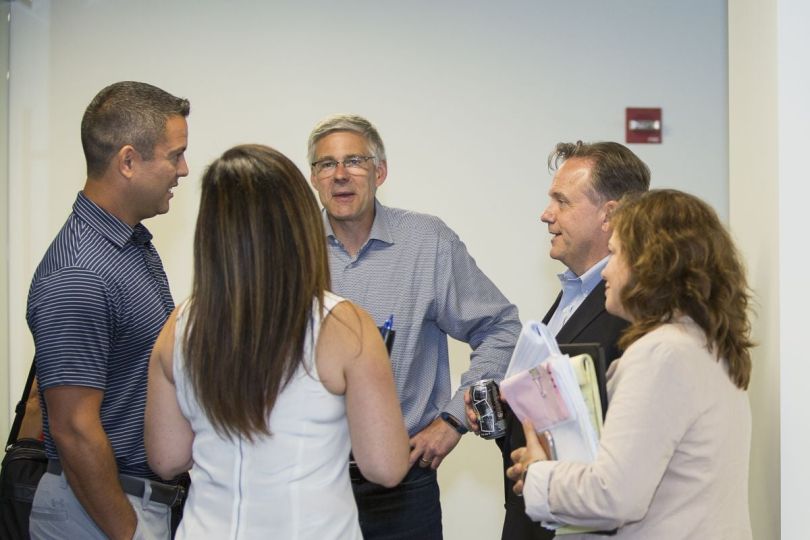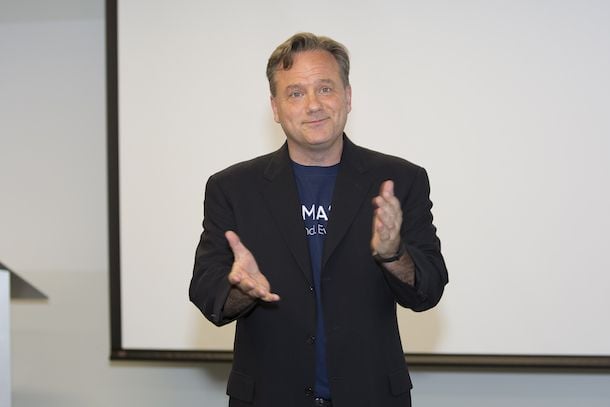
ItemMaster CEO Michael Murray is no stranger to challenges.
Murray has led units at AOL Time Warner, Sears and Catalina. Today, at ItemMaster, he’s propelling a team determined to build a better way to create and maintain data about the products we buy every day.
But one of his most formative lessons didn’t happen as an executive. It happened at age 15 when he was reprimanded by his boss for not thoroughly sweeping the aisles at the grocery store where he worked.
“He asked me: ‘How can I trust you to lock the doors if you can’t even sweep the floors?’” Murray said.
Murray still lives by the philosophy of getting the basics right first. We spoke with him about how he’s managed ItemMaster’s recent growth, his plans moving forward and what other experiences shaped his leadership style.

ITEMMASTER AT A GLANCE
FOUNDED: 2009.
EMPLOYEES: 81.
WHAT THEY DO: ItemMaster provides retailers with the data they need to drive sales and improve the customer experience.
HEADQUARTERED: The Loop.
CEO & PRESIDENT: Michael Murray, veteran of Sears, AOL and a neighborhood grocery store.
WHY CHICAGO?: In Murray’s view, Chicago is ripe with talent, and a place where “people know to put themselves to things that matter.”
TECHNOLOGY STACK: Primarily Java, Node.js and AWS.
CORE VALUES: Ownership and transparency.

What does ItemMaster do?
A lot of folks that I know used to ask whether we take pictures of food. To help a brand deliver itself into the 20th century marketplace, that was about all you needed. But in today's marketplace, it's really about providing structured data at scale. Manufacturers need a partner to wrap a product in the stories they want to share. Then you have to deliver that content to online and brick-and-mortar retailers, mobile applications and companies like Google and Facebook.
Our first step is packaged goods, but this is a challenge for all retailers. Earlier in my career, when I was chief marketing officer at Sears, we were trying to bring 13 different business units together in an online marketplace. That involved working with thousands of manufacturers, many of which were not prepared to provide the information they needed to have to sell their products online.
Online shopping has been around for a while, but people are increasingly turning to e-commerce for daily essentials. It seems like your timing in launching ItemMaster is pretty good?
Right, and the digital marketplace is finding its way into traditional retail. Walmart has more than 50 data scientists working on its retail environment, and they’re not just doing e-commerce. They're analyzing store-level transaction data, product data and store location data to better serve shoppers. Our data can be used where decisions are made about pricing, promotion, facing, slotting and whether a product is even carried.
If you build structured data at scale, it can work everywhere. It can work in e-commerce, mobile applications and large search engines, but it also works in planning, marketing and brick-and-mortar stores.

And as a standalone company, you can solve this problem once and for all rather than have every retailer figure it out on their own? How did that idea emerge?
We started as part of Peapod, which is a $750 million grocery e-commerce delivery platform. When that company was getting started in the early 1990s, the founders reached out to manufacturers for information they could use to sell their products online. But the manufacturers didn’t have it. Fast forward 27 years, and they still don’t. We started solving that problem for Peapod, and found a clear correlation between providing better content and driving more sales.
Your company has grown a lot in the past year. What has that experience has been like?
Our business is growing from a people and business perspective. If you're solving a real problem, the market comes to you. In 2016 we went from being the 14th biggest content service provider for Walmart to being the biggest one. When we came to them, we walked in the door with data on roughly 50,000 products. And that data was already structured and ready to flow into the marketplace. Our product is built for today’s marketplace, which means we’re ready to deliver results immediately, whether that’s for Instacart, Peapod or Walmart.
One of your long-term goals is to expand beyond consumer packaged goods. Tell me more about that.
Right now, our focus is to really build and support this market, because that’s where we came from. As we enter 2018, you'll definitely see additional products, like over-the-counter pharmaceuticals, health and beauty products, baby supplies and pet essentials — anything you would find in a Walgreens or a CVS or on Amazon. Those are easy expansions, because they connect with the network we're already building. Then we can solve the same problems for the same customers in international markets.
Where do you expect your team to be in the next year, say?
World domination is probably not right, right?
Probably not. But as your team continues to grow in that direction, how do you establish a sustainable company culture?
Culture's going to happen one way or another, so you have to have intention behind it. Everyone here has equity in the company, because we think owners make better decisions about what they do and how they do it. So we’re looking for people who act as owners of the business. In return, people are allowed to manage their own time and to make real decisions.
We also communicate very clearly about where we want to go. People like to say they’re on a journey, but we have a clear destination in mind and we’re constantly communicating about where we are and how we’re moving forward.

In your career, you’ve held many positions at a lot of different companies. How has that shaped your leadership style?
I know what it's like to be on successful teams, and I also know what it’s like to work for organizations where there are challenges. In every case, you pick up something from the great leaders that you see: those that empower, listen and know how to respond rather than react.
The one thing I’ve consistently found across organizations is that great teams move organizations forward. My job is to field the best team, which means finding people who know their roles and functions far better than anyone else in the organization. Then I give them the responsibility to lead in that space and play on the team.
What is the most formative experience you’ve had in your career?
I learned my first business lesson at 15 when I worked in a grocery store. I had just swept the aisles and I thought I was finished when the owner came in and told me that I hadn’t done a very good job. He asked me: “How can I trust you to lock the doors if you can’t even sweep the floors?”
Eventually, when I was 17, he did give me the keys to the store. But what he taught me was that you have to do the basics right. For every element of what you do, you need to commit yourself to doing great work. When you do that, more great things will happen for you as well as for the organization. It took a while for that to sink in, though. My first thought was: “Oh, great. I have to sweep the floors again.”
Are there any major challenges you've faced as a leader that you learned from?
You learn from success and failure. When you succeed, you can evaluate the choices you made and the resources you drew on in order to replicate it in your next role. In failures, you can look back at what you missed: signals you didn’t hear or assumptions you held onto for too long.
Especially at young, innovative companies, a lot of early decisions are based on assumptions because those companies are out to build something new. I guarantee you that our first plan wouldn’t have worked out because there were too many assumptions. But once you start building, it’s all about evaluating performance and adapting quickly. I don't believe there's a business out there that is based exactly on the business plan that was written.
That said, when you’re adapting, it’s important to respond rather than react. That means your first step should be to evaluate, not execute.






